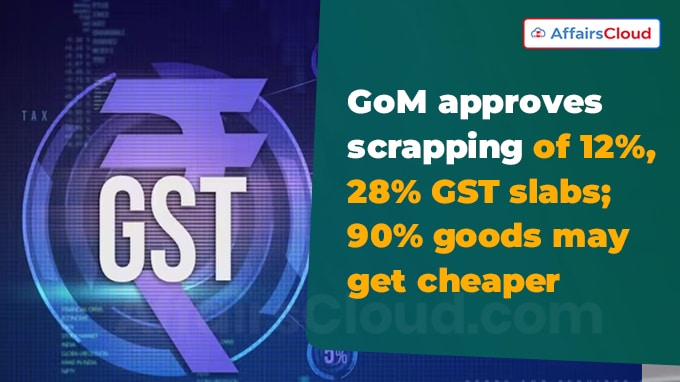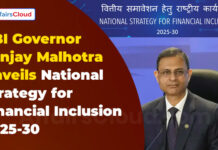 In August 2025, the Group of Ministers (GoM) on Goods and Services Tax (GST) rate rationalisation, headed by Samrat Choudhary, Deputy Chief Minister(DyCM) of Bihar, accepted the Government of India(GoI)’s proposal to reduce the current four-slab structure to two-slab structure i.e. 5% and 18%.
In August 2025, the Group of Ministers (GoM) on Goods and Services Tax (GST) rate rationalisation, headed by Samrat Choudhary, Deputy Chief Minister(DyCM) of Bihar, accepted the Government of India(GoI)’s proposal to reduce the current four-slab structure to two-slab structure i.e. 5% and 18%.
- This represents a major milestone in the reform of the indirect tax system.
Exam Hints:
- Event: GoM meeting on GST
- Chaired by: Samrat Choudhary
- New Tax Slabs: 5% (merit goods); 18% (standard goods)
- Proposed Shift:
- 99% of items at 12% to 5%
- 90% of items at 28% to 18%
- 40% GST slab earmarked for sin & luxury goods
Proposed GST Rate Rationalisation Framework:
Members of GoM: The six member GoM includes Uttar Pradesh (UP) Finance Ministers (FM) Suresh Kumar Khanna, Rajasthan Health Minister (HM) Gajendra Singh, West Bengal (WB) FM Chandrima Bhattacharya, Karnataka Revenue Minister Krishna Byre Gowda, and Kerala FM K N Balagopal.
Proposed Structure: The existing four-rate GST structure of 5%, 12%, 18%, and 28% is proposed to be replaced with a simplified two-rate system, 5% for merit goods and 18% for standard items.
- Under this reform, 99% of items currently taxed at 12% would be shifted to the 5%, while 90% of those under the 28% bracket would move to 18%.
- The panel proposed that 40% GST slab has been earmarked for sin and luxury goods under the new GST framework.
Health and Life insurance: The GoM also reviewed the GoI’s proposal to exempt GST on health and life insurance for individuals, which could lead to a revenue impact of around Rs. 9,700 crores annually.
Impact: The rate rationalisation is expected to simplify the indirect tax system and also ensuring relief for households, farmers and Micro, Small and Medium Enterprises (MSMEs).
Next Step – GST Council Review: The GoM’s recommendations will be forwarded to the GST Council, chaired by the Union Minister Nirmala Sitharaman,Ministry of Finance(MoF) and comprising representatives from all states.
- The Council will examine the proposals in its upcoming meeting before making a final decision.
About Goods and Services Tax (GST) :
GST: The GST is a Value-Added Tax (VAT) applied to most goods and services supplied for domestic consumption.
Background: The idea of introducing the Goods and Services Tax (GST) in India was first proposed in 2000, when then Prime Minister(PM) Atal Bihari Vajpayee set up a committee to design a GST model.
- The task force, headed by Vijay L. Kelkar, Advisor to the Finance Ministry, concluded that GST would significantly improve India’s tax structure.
Introduction: It was introduced in India on 1st July 2017 through the 101st Constitutional Amendment Act, marking one of the biggest indirect tax reforms in the country.
Global Adoption : The GST was first implemented as a tax regime in 1954 in France. Over time, it was gradually adopted by several other countries.




